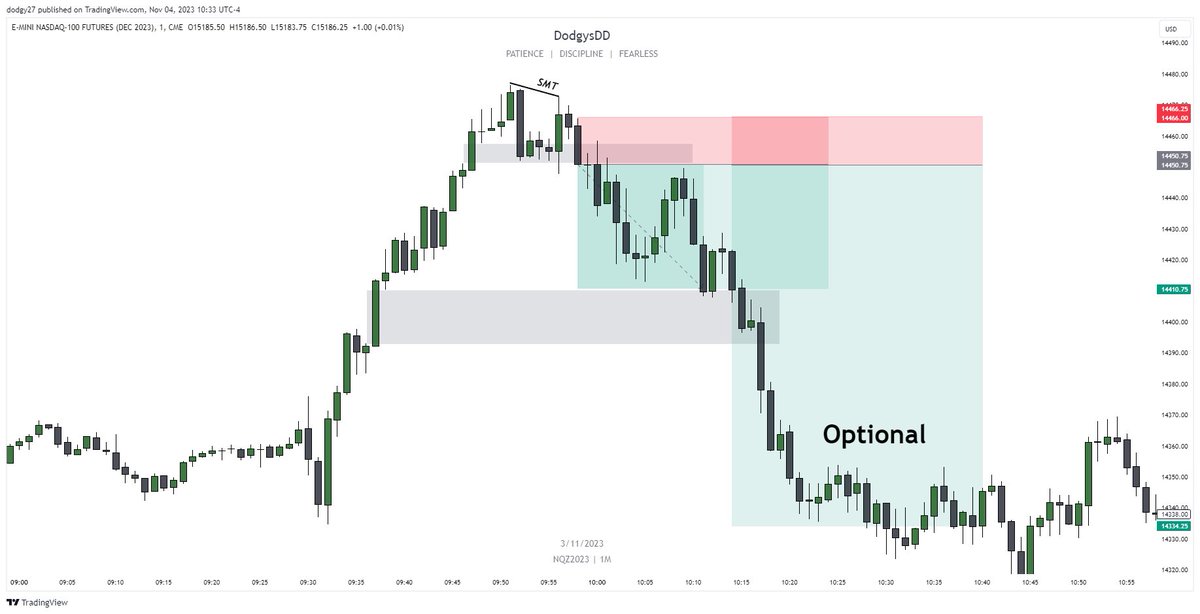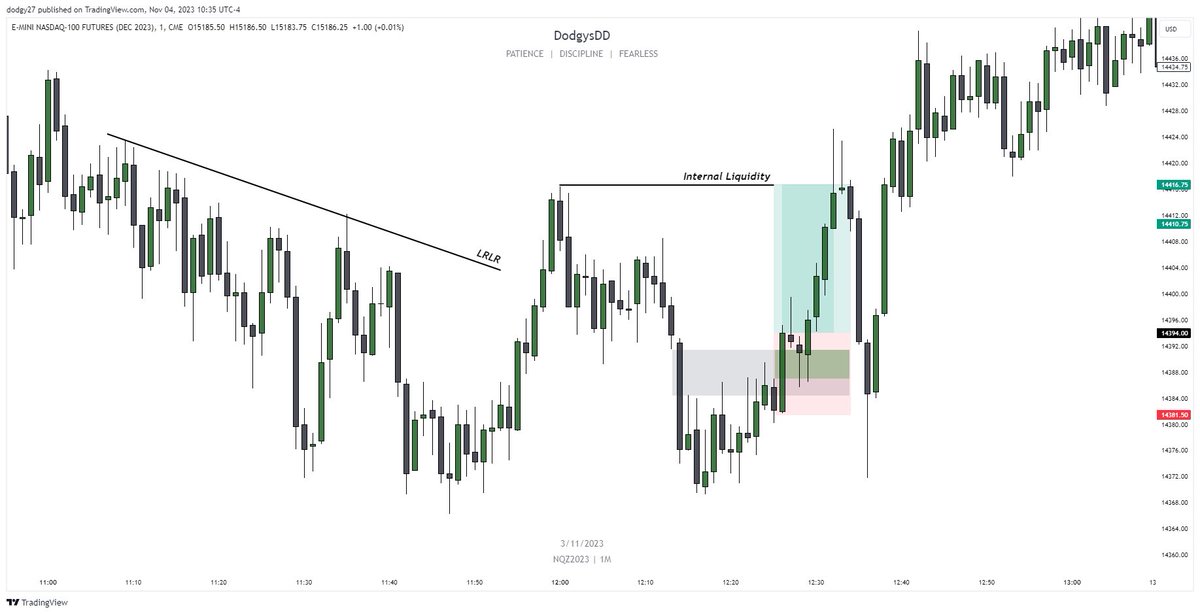Educational thread on how I use iFVGs🧵
In my opinion this is the best way to use iFVGs
In my opinion this is the best way to use iFVGs
What exactly is an iFVG?
This is an inversion fair value gap
Basically, a bearish FVG is CLOSED above and becomes support
A bullish FVG is CLOSED below and becomes resistance
This also counts as a market structure shift as well
Correct term: iFVG/inversion


This is an inversion fair value gap
Basically, a bearish FVG is CLOSED above and becomes support
A bullish FVG is CLOSED below and becomes resistance
This also counts as a market structure shift as well
Correct term: iFVG/inversion


The first thing you should understand is:
When should an iFVG actually occur? Well that’s basically asking when a bullish FVG should fail, or bearish FVG fail?
A bullish FVG should FAIL if we hit buyside and retrace, and a bearish FVG should fail if we hit sellside and retrace
When should an iFVG actually occur? Well that’s basically asking when a bullish FVG should fail, or bearish FVG fail?
A bullish FVG should FAIL if we hit buyside and retrace, and a bearish FVG should fail if we hit sellside and retrace
So in this example, I would expect a iFVG to occur since we just ran high of day, meaning there is no need to bounce off this FVG if there’s no more liquidity above to take:
Then I wait for it to fail (get closed below) then I short
Then I wait for it to fail (get closed below) then I short

So how do I use them properly for entries?
First things first, I make sure it’s a really obvious one.
It can’t be a million FVGs together, such as 3 in a row. Here are some bad examples of fair value gaps I would not be interested in using as inversions:


First things first, I make sure it’s a really obvious one.
It can’t be a million FVGs together, such as 3 in a row. Here are some bad examples of fair value gaps I would not be interested in using as inversions:


So you can clearly see in those examples, way too many iFVGs to use there
These examples show clear iFVGs that stick right out
In all these examples we have purged some sort of liquidity or low, making them a good one
They are also all singular FVGs


These examples show clear iFVGs that stick right out
In all these examples we have purged some sort of liquidity or low, making them a good one
They are also all singular FVGs


How do you enter and where does the stop go? This can be changed a bit from what I do…
I personally enter on the candle close after it closes through the FVG
I typically do not wait for retrace because I miss a lot of moves
The only time I do not market buy/short on an iFVG
I personally enter on the candle close after it closes through the FVG
I typically do not wait for retrace because I miss a lot of moves
The only time I do not market buy/short on an iFVG
is when the iFVG has really bad RR. Let’s say we close way below the FVG and the RR is now horrible, well then I will wait for retrace
So in this example, we close above the iFVG, however the RR was almost negative to the high, so I wait for the retracement for better RR


So in this example, we close above the iFVG, however the RR was almost negative to the high, so I wait for the retracement for better RR


In the above example, the RR was so bad if I were to market buy, so I would wait for retracement instead
In THIS example, no matter if you enter on the the close or not, RR is similar, so if you do not want to miss the move, get in on the close


In THIS example, no matter if you enter on the the close or not, RR is similar, so if you do not want to miss the move, get in on the close


It really all comes down to this: would you rather take a 2R trade and know you are getting filled, or try to wait for a 3R and no guarntee you get filled
Knowing both have a high win rate, the 2R is good enough for me, so I do not care about retracement
Knowing both have a high win rate, the 2R is good enough for me, so I do not care about retracement
If it is a 2R versus a 1R, then obviously I’ll wait for the 2R if the 2R has the retracement, but it does not matter, all depends on your risk.
STOP LOSS:
You can either have the stop loss above or below the old high
or
What I do is this:
My stop loss is if we close back the other way above/below the FVG
So if we activate an inversion and close above it, I’ll buy, and get out if we close back below
You can either have the stop loss above or below the old high
or
What I do is this:
My stop loss is if we close back the other way above/below the FVG
So if we activate an inversion and close above it, I’ll buy, and get out if we close back below
If you do the first option risk is easier to calculate, but for second option, you have to guesstimate the risk, so maybe size down a little if you do second option, but I think second option is better and that’s my personal preference
You do not want to see an iFVG disrespected


You do not want to see an iFVG disrespected


The other reason I prefer second option is because most times we close back below/above an iFVG, we end up hitting the low/high anyways, and I feel like long term it’s worth putting risk before that knowing it will probably hit anyways if we disrespect iFVG
This is exactly what I am talking about
-We go hit the old high anyways after the iFVG fails, so why let yourself put on more risk than you need to if you know we will run the high most of the time anyways if the iFVG fails
-We go hit the old high anyways after the iFVG fails, so why let yourself put on more risk than you need to if you know we will run the high most of the time anyways if the iFVG fails

So, that’s how I enter and exit
Ideally, my favorite targets for liquidity and what I look for is:
-Data high/lows
-Old highs/lows inside FVGs
-Equal highs/Equal lows
Ideally, my favorite targets for liquidity and what I look for is:
-Data high/lows
-Old highs/lows inside FVGs
-Equal highs/Equal lows
One A+ example of what I look for:
-Equal highs above (good liquidity pool
-Singular inversion entry
-Swept the low (liquidity
If we swept the lows, why would we expect the bearish FVGs to reject? We wouldn’t, so I use them as inversions.
-Equal highs above (good liquidity pool
-Singular inversion entry
-Swept the low (liquidity
If we swept the lows, why would we expect the bearish FVGs to reject? We wouldn’t, so I use them as inversions.

I have a more advanced lesson on my YouTube in this playlist here on iFVGs I long due to us not hitting internal liquidity, but this is a basic thread, so if you want to see my internal liquidity rule, watch this playlist: youtube.com/playlist?list=…
That’s it for now!
Remember, don’t take the ones that are bad RR, just tape read them as they will likely still work
This was a very basic thread, and next week I am putting out a bigger course on them combining them with MMXM
And it will go in depth much more and be more
Remember, don’t take the ones that are bad RR, just tape read them as they will likely still work
This was a very basic thread, and next week I am putting out a bigger course on them combining them with MMXM
And it will go in depth much more and be more
complete than this thread… but of course you could just watch my YouTube for free / use this thread for free
This paid course is for people who want to put more work in, but anyways stay tuned
This paid course is for people who want to put more work in, but anyways stay tuned
I also have a discord here if you have any questions:
I also have a private room where I live stream everyday and teach live time which I will not promote a link as I am sure you are smart enough to find it😂
discord.gg/dodgysdungeon
I also have a private room where I live stream everyday and teach live time which I will not promote a link as I am sure you are smart enough to find it😂
discord.gg/dodgysdungeon
Happy you for reading, Happy New Year everyone❤️
Please do not drive drunk tonight. I want to see you wake up and study these entries this week, not be in the hospital.
Please do not drive drunk tonight. I want to see you wake up and study these entries this week, not be in the hospital.
• • •
Missing some Tweet in this thread? You can try to
force a refresh














